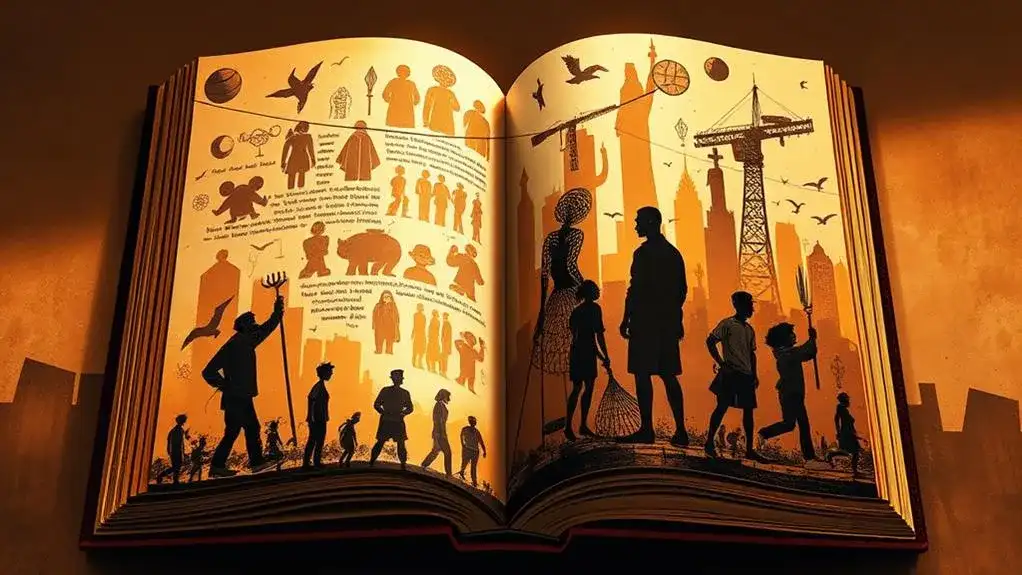Introduction: A Novel That Transcends Boundaries
Jeffrey Eugenides’ Middlesex is a genre-defying novel that boldly navigates complex themes of identity, belonging, and transformation. Through the life of Calliope Stephanides—later known as Cal—the novel offers readers a poignant exploration of what it means to exist in between worlds: between genders, cultures, generations, and societal norms.
Winner of the 2003 Pulitzer Prize for Fiction, Middlesex is not just a coming-of-age story. It is a generational epic that traverses time and place—from a small Greek village during the fall of the Ottoman Empire to industrial and post-industrial Detroit. Eugenides’ masterwork dares to question the binaries that define us—male and female, past and future, belonging and alienation.
This in-depth article will explore the narrative arc, characters, historical backdrop, major themes, and the cultural impact of Middlesex. It will also offer further reading suggestions and reflect on how this powerful novel continues to resonate in today’s sociocultural landscape.
Part I: The Architecture of the Narrative – A Story Spanning Continents and Generations

At its core, Middlesex is a family saga. The novel traces the genetic and emotional inheritance of the Stephanides family, beginning with the incestuous union of Lefty and Desdemona Stephanides, who flee war-torn Smyrna and settle in Detroit. Their secret sets in motion a ripple effect that will eventually culminate in the birth of their intersex grandchild, Calliope.
Narrated retrospectively by Cal, now an adult living in Berlin and working as a diplomat, the novel unfolds in a sweeping, non-linear fashion. Cal serves as both protagonist and omniscient narrator, telling his family’s story from before his birth. This unusual narrative strategy adds both intimacy and distance—it’s personal yet mythic, grounded in memory and laced with self-awareness.
The Epic and the Personal
Eugenides balances mythic storytelling with intimate character detail. The novel’s style evokes classical epics like Homer’s Odyssey, a fitting reference point for a Greek-American family saga. Cal often adopts a heroic tone when describing his journey, yet his vulnerabilities remain at the forefront, giving the novel emotional resonance.
The plot is meticulously constructed, moving from historical events like the Greco-Turkish War and the 1967 Detroit race riots to Cal’s internal revelations about gender and selfhood. The past and present blur, creating a tapestry where personal identity is inextricably linked to ancestral choices and broader socio-political currents.
Part II: Exploring Identity and Transformation
At the heart of Middlesex lies one of literature’s most nuanced portrayals of gender identity. Calliope’s transition into Cal is not framed as a traditional transgender narrative, but as a unique journey shaped by biology, family history, and personal discovery. Born with 5-alpha-reductase deficiency syndrome, Cal possesses ambiguous genitalia—a fact overlooked until puberty, when Calliope’s body diverges from female development.
The Intersex Experience in Literature
Until Middlesex, few mainstream literary works had attempted to center an intersex protagonist with such depth and sensitivity. Eugenides gives voice to a rarely represented identity, avoiding sensationalism while embracing the complexity of Cal’s self-understanding. The novel critiques the medicalization of intersex bodies, especially in scenes involving Dr. Luce, a sexologist who insists that Calliope remain female for social convenience.
Cal ultimately chooses to identify as male—not because society tells him to, but because it feels true to his sense of self. His decision is both a reclamation of agency and a rejection of imposed identity. The message here is clear: gender is not destiny, and identity must be self-authored.
Part III: Heritage and Immigration – The Weight of the Past
Identity in Middlesex is not just personal; it’s ancestral. Eugenides devotes the novel’s first third to the Stephanides’ journey from Smyrna to America, grounding Cal’s genetic makeup and emotional landscape in his family’s history. This historical grounding allows readers to understand the broader context of Cal’s existence—not merely as an intersex individual but as the product of generations of migration, trauma, secrecy, and adaptation.
The Immigrant Narrative
Like many immigrant novels, Middlesex is steeped in the longing for reinvention. Lefty and Desdemona arrive in America hoping to shed the burdens of their past, but their genetic legacy and unresolved guilt follow them. Their arranged and incestuous marriage is kept secret, yet its consequences echo through the family tree.
Detroit becomes a symbol of hope and disillusionment. Once a booming metropolis powered by the automotive industry, it later succumbs to economic decline, racial tensions, and social fragmentation. The city’s transformation mirrors that of the Stephanides family—from proud, self-reliant immigrants to fractured individuals wrestling with identity crises in a changing world.
Part IV: Family Secrets and the Legacy of Silence
The novel thrives on secrets: secrets about origins, bodies, and desires. From the concealed incest at the story’s origin to the silence around Calliope’s condition, Middlesex explores how withholding truth distorts reality and delays healing.
Inheritance Beyond Genes
Cal’s physical condition is a genetic inheritance, but Eugenides also emphasizes the emotional inheritance passed down through generations. The fear and shame of Lefty and Desdemona’s union color the atmosphere in which Milton and Tessie raise their children. The lack of open communication becomes a metaphor for the broader societal unwillingness to discuss bodies and identities that defy convention.
Milton’s obsessive desire for normalcy and success—expressed through his rigid parenting and business ventures—illustrates how the American Dream can become a trap. His tragic end during a chase to protect the family secret from being exposed highlights the costs of denial and fear.
Part V: Gender as a Social Construct
One of the novel’s central inquiries is the extent to which gender is biologically determined versus socially constructed. While Cal’s body contains both male and female characteristics, it’s the societal response to those traits that determines much of his struggle.
A Critique of Binary Thinking
“Middlesex invites readers to question the binary understanding of gender. The novel suggests that rigid categorizations fail to accommodate the richness of human experience. Cal doesn’t fit neatly into either category, and the discomfort this creates in others reflects the limitations of societal imagination.
Through Cal’s school experiences, romantic confusion, and encounters with the medical establishment, Eugenides critiques how systems—from schools to hospitals—enforce gender conformity. Cal’s eventual self-definition is not a declaration of manhood over womanhood, but a rejection of imposed labels in favor of self-authored truth.
Part VI: Major Characters and Their Arcs
The strength of Middlesex lies in its characters—flawed, rich, and unforgettable.
Cal/Calliope Stephanides
As narrator and protagonist, Cal is reflective, intelligent, and deeply human. His journey from Calliope to Cal is told with emotional clarity and philosophical depth. He is both observer and participant in his life story, struggling to reconcile internal truths with external expectations.
Lefty and Desdemona Stephanides
Their relationship—both taboo and tender—forms the emotional and genetic root of the novel. Their love, born in secrecy and nurtured through hardship, complicates moral judgments. Desdemona’s later years are marked by guilt and superstition, reflecting her Greek Orthodox roots and inability to fully adapt to American life.
Milton and Tessie Stephanides
Milton, Cal’s father, is a complex figure—ambitious, patriotic, yet emotionally distant. Tessie is more nurturing but equally constrained by societal expectations. Their relationship, while loving, is strained by unspoken fears and frustrations.
Chapter Eleven
Cal’s older brother, nicknamed Chapter Eleven after the bankruptcy term, serves as both comic relief and symbol of the American Dream’s failure. His collapse into financial and existential ruin parallels Detroit’s decline and underscores the theme of disillusionment.
Part VII: Historical Context – War, Migration, and Civil Unrest

Eugenides uses historical events not as background noise, but as essential threads in the narrative fabric. The Greco-Turkish War, the rise of Fordism, Prohibition, and the 1967 Detroit riots all shape the Stephanides family’s choices and experiences.
Detroit: A Microcosm of American Transformation
Detroit’s transformation from a booming industrial hub to a city marked by racial tensions and economic decay serves as a parallel to Cal’s journey. The city’s decline mirrors the unraveling of rigid identities and the emergence of a more fluid, complicated reality.
Part VIII: Reader Reception and Cultural Impact
Middlesex has sparked critical and popular acclaim since its publication. Its innovative narrative structure, lyrical prose, and empathetic handling of taboo topics earned Eugenides a place among contemporary literary greats. Readers from all walks of life have found themselves reflected in Cal’s struggle for authenticity.
Praise and Critique
While lauded for its ambition and sensitivity, some readers have noted that the novel’s sprawling scope occasionally slows the pacing. Yet many agree that its depth and character development far outweigh any structural imperfections.
Intersex activists have had mixed reactions. Some praise the visibility and respectful portrayal, while others critique the novel for portraying intersex conditions as narrative devices. Eugenides himself has acknowledged these complexities, stating that he approached the story as a novelist, not a spokesperson.
Part IX: Further Reading and Literary Companions
If Middlesex speaks to you, consider diving into these related works:
By Eugenides:
-
The Virgin Suicides – A haunting meditation on suburban adolescence and collective memory.
-
The Marriage Plot – Explores love and identity in the context of literature, faith, and mental illness.
-
“Bronze” – A short story touching on cultural identity and loss.
Related Themes:
-
Orlando by Virginia Woolf – A gender-bending novel that questions the fixity of identity.
-
Written on the Body by Jeanette Winterson – A lyrical exploration of love without gender labels.
-
Hermaphrodites and the Medical Invention of Sex by Alice Dreger – A nonfiction work examining how intersex individuals have historically been treated by medicine and society.
Conclusion: Becoming Through the In-Between
Middlesex invites readers into a journey of becoming—of forging identity in the face of genetic destiny, societal expectation, and cultural memory. Cal’s narrative teaches us that identity is neither fixed nor singular; it is fluid, inherited, chosen, and discovered. Like the city of Detroit, like the family from Smyrna, like Cal himself, we are all in flux.
As you turn the final page, you may find that Middlesex has become more than a novel. It is a mirror, a map, a challenge. It whispers that to understand ourselves fully, we must look both backward and inward—and that sometimes, the in-between places hold the greatest truth.



